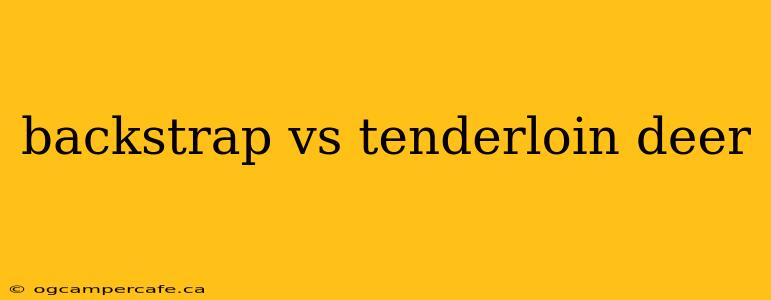Choosing between a deer backstrap and tenderloin often sparks debate among hunters and venison enthusiasts. Both cuts offer exceptional tenderness and flavor, but understanding their nuances helps determine which best suits your culinary needs. This detailed comparison explores the characteristics, cooking methods, and overall taste profiles of these prized cuts of venison.
Understanding the Cuts: Backstrap vs. Tenderloin
Both the backstrap and tenderloin come from the deer's loin area, contributing to their inherent tenderness. However, their location and muscle composition lead to subtle differences.
The Backstrap: A Versatile Venison Classic
The backstrap, also known as the dorsal muscle, runs along the deer's spine. It's a long, relatively lean muscle, providing a good amount of meat. Its shape makes it versatile for various cooking methods.
Characteristics:
- Leaner: Generally leaner than the tenderloin, offering a slightly drier texture when cooked improperly.
- Flavorful: Possesses a rich, gamey flavor characteristic of venison.
- Versatile: Suitable for grilling, pan-searing, roasting, and even jerky.
The Tenderloin: The Pinnacle of Venison Tenderness
The tenderloin, also called the filet mignon of the deer, is a small, cylindrical muscle located beneath the backstrap. It's known for its unparalleled tenderness and melt-in-your-mouth quality.
Characteristics:
- Most Tender: The most tender cut of venison, owing to its minimal muscle usage.
- Rich Flavor: Offers a concentrated, intensely flavorful venison taste.
- Delicate: Requires careful handling and cooking to avoid overcooking and dryness.
Taste and Texture Comparison: A Head-to-Head Showdown
While both cuts are incredibly flavorful, there are subtle differences:
- Tenderness: The tenderloin wins hands down in terms of tenderness. Its delicate texture is unmatched by any other venison cut. The backstrap, while tender, offers a slightly chewier texture.
- Flavor: The backstrap possesses a broader, more pronounced gamey flavor, while the tenderloin boasts a richer, more concentrated taste.
- Leanness: The backstrap is leaner, requiring careful cooking to avoid dryness. The tenderloin, being naturally more tender, can tolerate slightly higher cooking temperatures without becoming tough.
Cooking Methods: Tailoring to Each Cut's Strengths
Optimal cooking methods vary depending on the cut:
Backstrap:
- Grilling: Marinating adds moisture and flavor before grilling to medium-rare.
- Pan-Searing: A quick sear creates a flavorful crust while retaining juicy meat.
- Roasting: Ideal for larger backstraps, roasting allows for even cooking and enhanced tenderness.
Tenderloin:
- Pan-Searing: Achieves a beautiful sear while maintaining its delicate texture.
- Roasting (Short Roasting): Short roasting helps retain moisture and tenderness. Overcooking is the enemy of a tenderloin.
- Sous Vide: This method ensures perfectly even cooking, resulting in incredibly tender and juicy meat.
Conclusion: The Verdict Is… It Depends!
The "better" cut ultimately depends on personal preference and intended culinary application.
- Choose the backstrap for: A leaner, more versatile cut suitable for various cooking styles. Its robust flavor stands up well to strong marinades and seasonings.
- Choose the tenderloin for: An unforgettable culinary experience emphasizing unparalleled tenderness and rich, concentrated venison flavor. This is a cut best savored for special occasions.
Ultimately, both the backstrap and tenderloin are prized cuts offering unique culinary advantages. Understanding their characteristics allows you to choose the perfect cut for your next venison dish.
